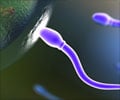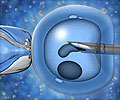In a bid to revolutionise in vitro fertilization (IVF) treatment, Brit scientists have developed a new technology, called Raman spectroscopy, to find sperm with healthy.
In a bid to revolutionise in vitro fertilization (IVF) treatment, Brit scientists have developed a new technology, called Raman spectroscopy, to find sperm with healthy, intact DNA for better chances of a healthy embryo.
Usually, infertile men with low sperm count or abnormal sperms opt for IVF, in which scientists use light microscopes to find any sperm cell, and then inject it directly into an egg to fertilize it.But the biggest shortcoming with this method is that broken sperm often means broken DNA.
And Alistair Elfick, a professor at the University of Edinburgh in the United Kingdom, who developed the technique using Raman spectroscopy, said that the DNA, and not the sperm cell itself, is what is really important for a developing embryo.
"It's interesting research because is shows that there are finer distinctions for sperm other than dead or alive," Discovery News quoted Michael Morris, a Raman spectroscopy expert at the University of Michigan who was not involved in the research, as saying.A sperm cell is pretty stripped down. The DNA has no explicit role in delivering itself, it's just the payload," said Elfick.
While a light microscope kicks a sperm cell's metaphorical tires, Raman spectroscopy pops the trunk to directly examine the DNA payload.
In Raman spectroscopy, the scientists shine a beam of light on the 23 chromosomes enclosed in the head of the sperm.
As damaged DNA refracts light differently than intact DNA, the researchers can examine the resulting light to determine which DNA is the most likely to lead to a healthy human embryo.
However, when it comes to put the theory into practice, it's another picture altogether.
To date, scientists haven't injected Raman spectroscopy-certified sperm into eggs and examined how many more embryos are created or how healthy they are.
There are many limitations to the technique as Raman spectroscopy can only examine tens to hundreds of sperm cells at a time, which may not be a big problem for many infertile men, as this is also roughly the number of sperm they can produce during an ejaculation.
While some scientists fear injecting Raman-examined sperm into an egg, Alistair and Morris are confident that the energy contained in the laser beam is too small to cause any permanent damage to the sperm cell.
But according to Max Diem, a professor at Northwestern University who uses Raman spectroscopy to examine human egg cells, useful reading will require potentially harmful amounts of laser energy.
"This is not just around the corner for couples," said Diem.
He stressed that more testing is necessary before any Raman spectroscopy examined sperm and egg union is placed into a human uterus.
Source-ANI
SRM















